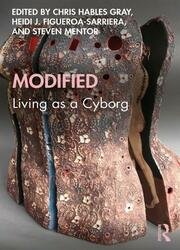Modified: Living as a Cyborg
- Добавил: literator
- Дата: 15-05-2021, 13:37
- Комментариев: 0
 Название: Modified: Living as a Cyborg
Название: Modified: Living as a CyborgАвтор: Chris Hables Gray
Издательство: Routledge
Год: 2020
Страниц: 331
Язык: английский
Формат: pdf (true)
Размер: 28.2 MB
Human integration with complex technologies goes back to clothes, cooking, and language, but has accelerated incredibly in the last few centuries, with interest spreading among scientists, coders, people with sophisticated implants, theorists, and artists.
I have conducted two specific implant experiments to investigate the merger between humans and technology, thereby creating a cyborg. What I have attempted to do in the Chapter 4 is to give some indication of the experiments along with the reasoning behind the arrangement and my feelings which resulted. Both experiments describe work in which technology was implanted into my body by a doctor/surgeon. In the second of these the technology was implanted into my nervous system during a two hour operation performed by two consultant neurosurgeons.
The history of the cyborg in the early modern man-machine is based on these two related facets of techno-bodies. First, is the mechanistic view of the body as an engine composed of multiple parts, seen today as rather unremarkable: surgical procedures such as inserting stents in arteries to maintain unimpeded blood flow, or prosthetic limbs, or the replacement of organs, derive from a mechanistic understanding of the body’s visible part as mechanisms within a system or engine. Second, the view of the mind or consciousness as a series of electrochemical reactions derives from a mechanistic or materialistic understanding of the fine particles within the body.
This early modern framing, the man-machine with his (certainly his) body electric, did empower medicine and computer science with fruitful analogies. It also became central to economic thinking, where zombie just-so stories of cyborg models drove neo-liberal capitalism to unparalleled political dominance around the world. Meanwhile, in more and more businesses, humans and machines are being ever more intimately integrated, producing what Chuck Piazza labeled networked cyborgs, an adaptable intelligent cyber-socio organization. This could be empowering for the individual workerborg, but usually it is not. “We are an Extension of the Machine” argues an anonymous Amazon Worker, not as a celebration of this fact. Another Amazon Worker comments, “We are disposable.” These are linked. Workers are in the end “interchangeable”... Of course, this is true of almost all workers in modernity and, even more, in postmodernity. Machines and humans working together mean smart systems and intelligent cogs, but cogs many workers remain.
Addressing topics including race, gender, sexuality, class, conflict, capitalism, climate change, disability and beyond, this collection also explores the differences between robots, androids, cyborgs, hybrids, post-, trans-, and techno-humans, offering readers a critical vocabulary for understanding and discussing the cyborgification of culture and everyday life.
Compelling, interdisciplinary, and international, the book is a perfect primer for students, researchers, and teachers of cyberculture, media and cultural theory, and science fiction studies, as well as anyone interested in the intersections between human and machine.
Скачать Modified: Living as a Cyborg
[related-news] [/related-news]
Внимание
Уважаемый посетитель, Вы зашли на сайт как незарегистрированный пользователь.
Мы рекомендуем Вам зарегистрироваться либо войти на сайт под своим именем.
Уважаемый посетитель, Вы зашли на сайт как незарегистрированный пользователь.
Мы рекомендуем Вам зарегистрироваться либо войти на сайт под своим именем.
